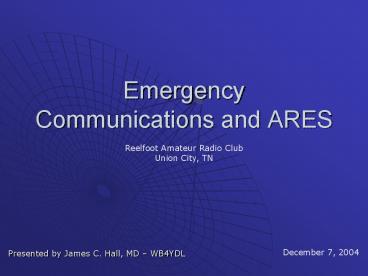Emergency Communications and ARES PowerPoint PPT Presentation
1 / 21
Title: Emergency Communications and ARES
1
Emergency Communications and ARES
Reelfoot Amateur Radio Club Union City, TN
December 7, 2004
- Presented by James C. Hall, MD WB4YDL
2
Tennessee ARES Structure
Larry Marshall WB4NCW SM
Sheila Talent KB4G SEC
Ken AF4ZR West TN ASEC
Tom K1KY Middle TN ASEC
Mark AG4OA East TN ASEC
3
Tennessee ARES Structure
Ken AF4ZR West TN ASEC
Gary W4GT District 2 DEC
Randy WB4LHD District 1 DEC
Dave K4WWV District 3 DEC
4
Tennessee ARES Structure
Gary W4GT District 2 DEC
District 2 ECs Carroll David KE4VJC Dyer /
Lake Ed KE4UJP Gibson Greg KD4UJT Henry
Jeffrey W4JPG Obion Jamie WB4YDL Weakley
Alan KA4BNI
5
Amateur Radio Emergency Organizations
- ARES Amateur Radio Emergency
Service - RACES Radio Amateur Civil Emergency Service
- Skywarn
6
ARES Membership
- Purpose
- Organize amateur communications response during a
disaster or crisis. - Requirements
- ARRL membership not required
- Not necessary to spend money
- Dont have to spend a lot of time just dedicate
your spare time.
7
Liaison with Served Agencies
- ARRL has MOUs with the following
- American Red Cross
- National Weather Service
- Federal Emergency Management Agency (FEMA)
- Assoc. of Public-Safety Communications Officials
(APCO) - National Communications System
8
Served Agencies (cont)
- National Assoc. of Radio and Telecommunications
Engineers - Salvation Army
- Society of Broadcast Engineers
- Radio Emergency Associated Communications Teams
(REACT)
9
National Disaster Medical System
- ARRL has no formal agreement, but lends informal
support to its operations usually at section
level - Purpose is to establish single national medical
response capability - Disaster Medical Assistance Team
- Evacuation capability
- Voluntary hospital network
10
Community Response
- Community Emergency Response Team CERT
- ARES/RACES contribute to community response
during a disaster - CERT training available by FEMA and by
local/regional emergency organizations - Training includes fire safety, hazardous
materials and terrorist incidents, disaster
medical operations and search and rescue.
11
Communications Emergency
- A communications emergency exists when a critical
communications system failure puts the public at
risk. - Examples
- storm knocks out telephone lines or radio towers.
- massive increase in use of a communications
system that causes it to overload - Failure of key component in a system that has
widespread consequences i.e. 911 failure
12
Emcomm Volunteer
- Wide variety of backgrounds, experience and skill
levels - Common attributes
- desire to help others without personal gain
- work as member of a team
- take direction from others
13
How Do You Fit In ?
- Amateur Radio Operators are communications
commandos - Hams have the ability to rapidly enlarge their
communications capacity to meet growing needs in
an emergency something commercial and public
safety systems can not do.
14
How Do You Fit In ?
- Many of the skills are the same ones used in
daily ham activities. - Other skills are specific to emergency
communications and must be learned. Without these
skills, you could easily become part of the
problem.
15
Day-to-Day vs. Emergency Communication
- Emergency communications involve both amateur and
non-amateur operators. - Emergency operations happen in real time.
- Emergency communicators often deal with several
continuous nets simultaneously to pass critical
messages within a limited timeframe. - Emergency communicators are often asked to
organize and coordinate field operations with
little or no warning. - Emergency communicators may need to interact with
several key organizations simultaneously.
16
Day-to-Day vs. Emergency Communication
- Emergency stations must be portable.
- Emergency communicators contact specific stations
quickly. - Emergency operations have no schedule.
- Amateur radio emergency communicators have the
equipment, skills, and knowledge to create
additional capacity in a very short time.
17
Anatomy of a Communications Emergency
- Early Phase no immediate need for emergency
communications - - watch or warning periods monitor
developments, prepare to deploy if a request for
assistance comes. - Served agency puts out call for volunteer
communicators. - - EOC (emergency operations center), field
locations, or both.
18
Anatomy of a Communications Emergency
- Rapid Response Teams (RRT)
- - small sub-group deploys minimal response in
a very short time. - - backed up by more robust response in an
hour or two. - Resource Net
- - Set up to handle incoming communications
volunteers and direct resources where they are
most needed. - - Volunteers not assigned to a task check in
and monitor the net.
19
Anatomy of a Communications Emergency
- Operations depends on the agency served and the
circumstances. - - staffing shelters to handle calls for
information, supplies, and personnel. - - collecting and transmitting damage reports.
- - pass health welfare inquiries to / from
refugee centers. - - logistical needs of the served agency
(supplies, equipment, personnel).
20
Anatomy of a Communications Emergency
- Over time, the need for emergency communications
networks will diminish and eventually the
networks will be dismantled and closed. - The emergency communicators group should then
review the effectiveness of its response soon
after operations are closed.
21
A Day of Infamy
- Original radiogram sent by Commander in Chief of
Pacific Fleet (CINCPAC)

